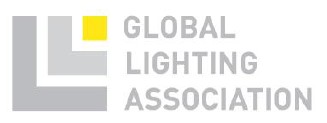 |
Global Lighting Association (GLA) logo. (GLA/LEDinside)
|
Position
The Global Lighting Association (GLA) cautions against the establishment of regulatory or other minimum performance requirements for a colour rendering index (Ra) of greater than 80 for indoor lighting applications. For Europe, the GLA supports retention of legal minimum requirements on colour rendering (Ra) at the current level as defined in the EU Eco-design Regulations (EC 244/2009, EC 245/2009, EC 1194/2012). In the United States, the GLA supports the Environmental Protection Agency’s Energy Star Program’s current minimum requirement of 80 CRI.
The flexibility afforded by this allowance permits further innovation in the field of colour quality, colour acceptance and colour preference, while promoting energy efficiency and consumer satisfaction at competitive prices. This will facilitate the continued evolution and adoption of LED lighting worldwide.
The Global Lighting Association supports the need for an additional colour quality metric - for example, a colour saturation metric, in conjunction with the well-established fidelity metric Ra.
Reasoning
Higher legal minimum requirements for the colour rendering index (Ra) will not result in improved colour quality or acceptance, as Ra (representing colour fidelity) is only one aspect of colour quality. Colour saturation or ‘colourfulness’ is another important factor contributing to colour quality which - at least for LED lighting - is not captured in Ra. Hence consumer acceptance of lighting products will not necessarily be increased by higher Ra values (e.g. above 80 for indoor applications).
Higher legal minimum requirements for Ra will impede innovation in these other aspects of colour quality, such as colour saturation, white light perception and personal preference. Moreover, higher legal minimum requirements for Ra can, in general, result in less energy efficient light sources and therefore are contrary to the objective of minimising energy use.
The Colour Rendering Index (Ra) debate
There are numerous performance features which consumers focus on when selecting lighting products and in determining their satisfaction with them. Colour rendering index is only one of these factors. The colour rendering index is a measure of how well the light source reproduces eight specific colours in comparison to an artificial reference light source. The maximum Ra value of 100 is achieved when the eight colours are rendered identically (for the test and reference light sources), with decreasing Ra values for increasing colour differences between the test light source and the artificial reference light source.
Ra and its applicability have received much attention in recent years within standardisation groups, as well as from regulators. It is sometimes wrongly assumed that the higher the Ra value, the greater the appreciation of consumers. Some of the literature points to the contrary, because other factors such as colour saturation, colour temperature and the precise position of the colour point in the chromaticity diagram are also appreciated by consumers, perhaps to a greater extent than colour fidelity.
Colour saturation, a different metric, can also be defined relative to the reference light source. Therefore, colour saturation can only be changed by increasing the difference between the reference source and the test source, which unavoidably lowers the Ra value. Manufacturers should be able to carefully balance colour saturation with the Ra value to optimise consumer preference. Limiting Ra to values above 80 for indoor applications simply blocks the development of light sources that have other attractive aspects, like increased colour saturation.
Regulations and Colour Rendering Index
Many national and regional governments globally are adopting lighting regulations, including minimum performance requirements. Many of these regulations also include requirements relating to the colour rendering index Ra. In such regulations, the Ra is often the only metric for colour quality.





 CN
TW
EN
CN
TW
EN






